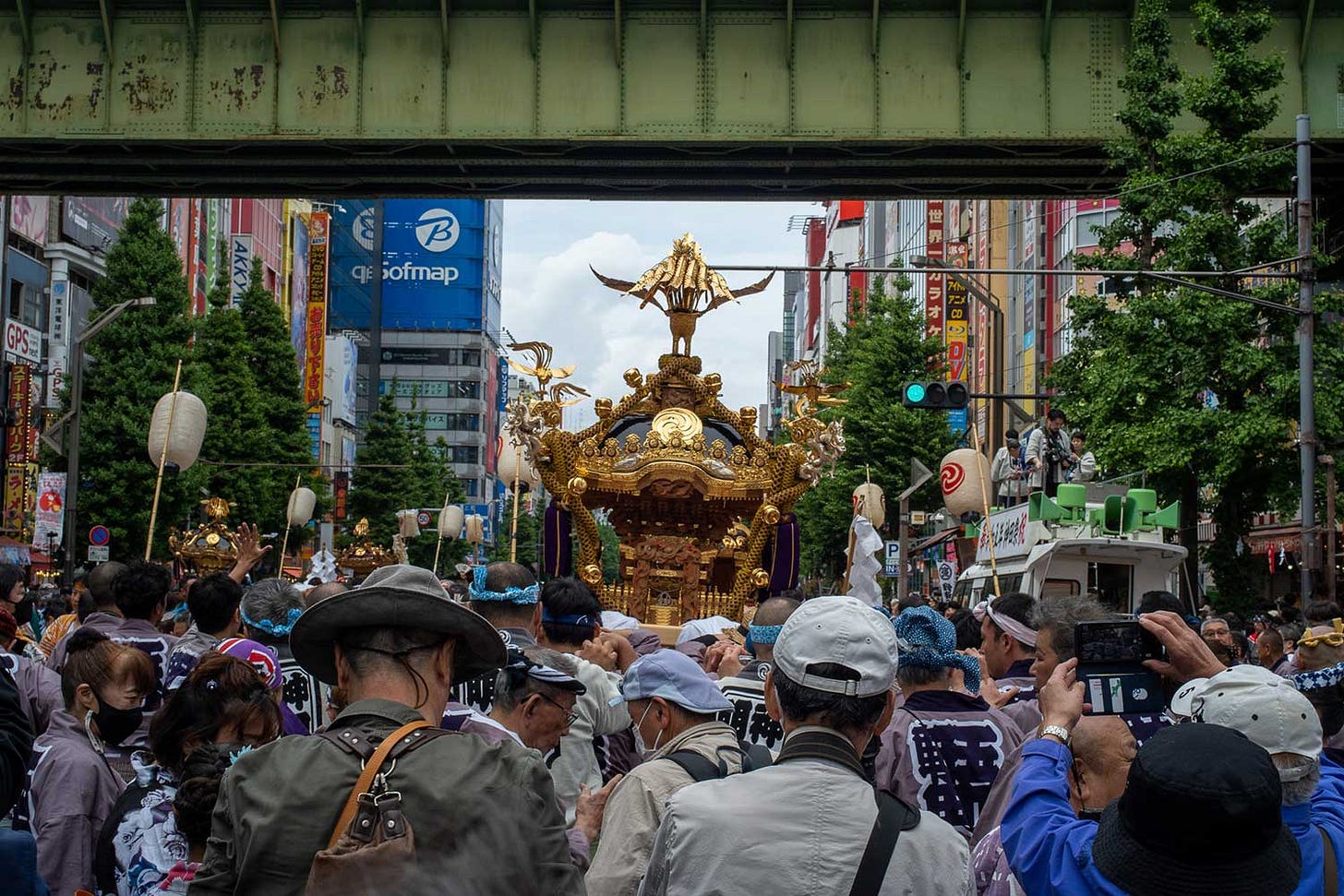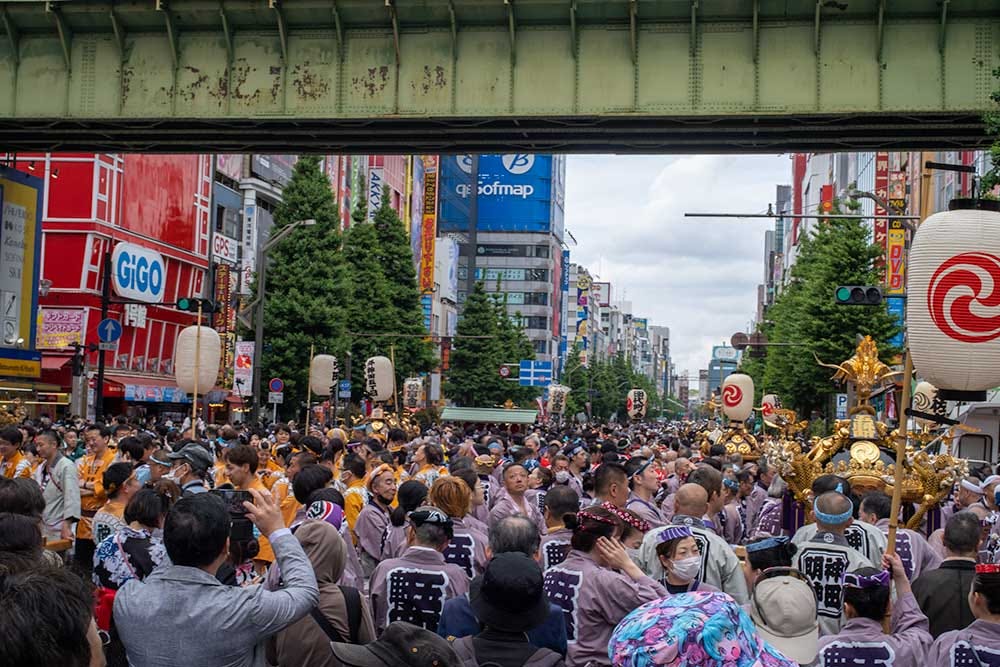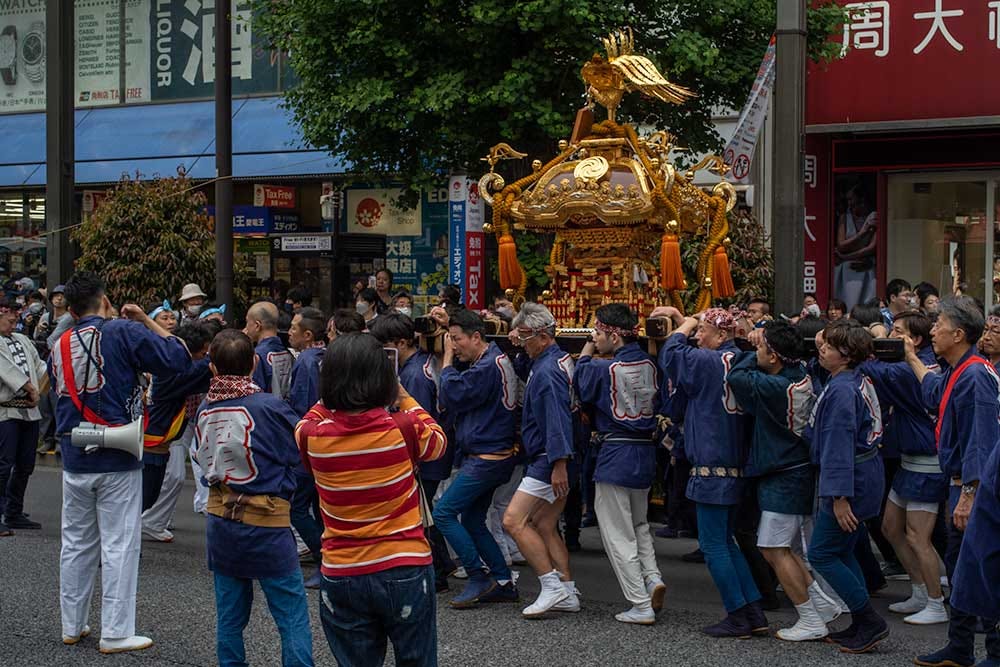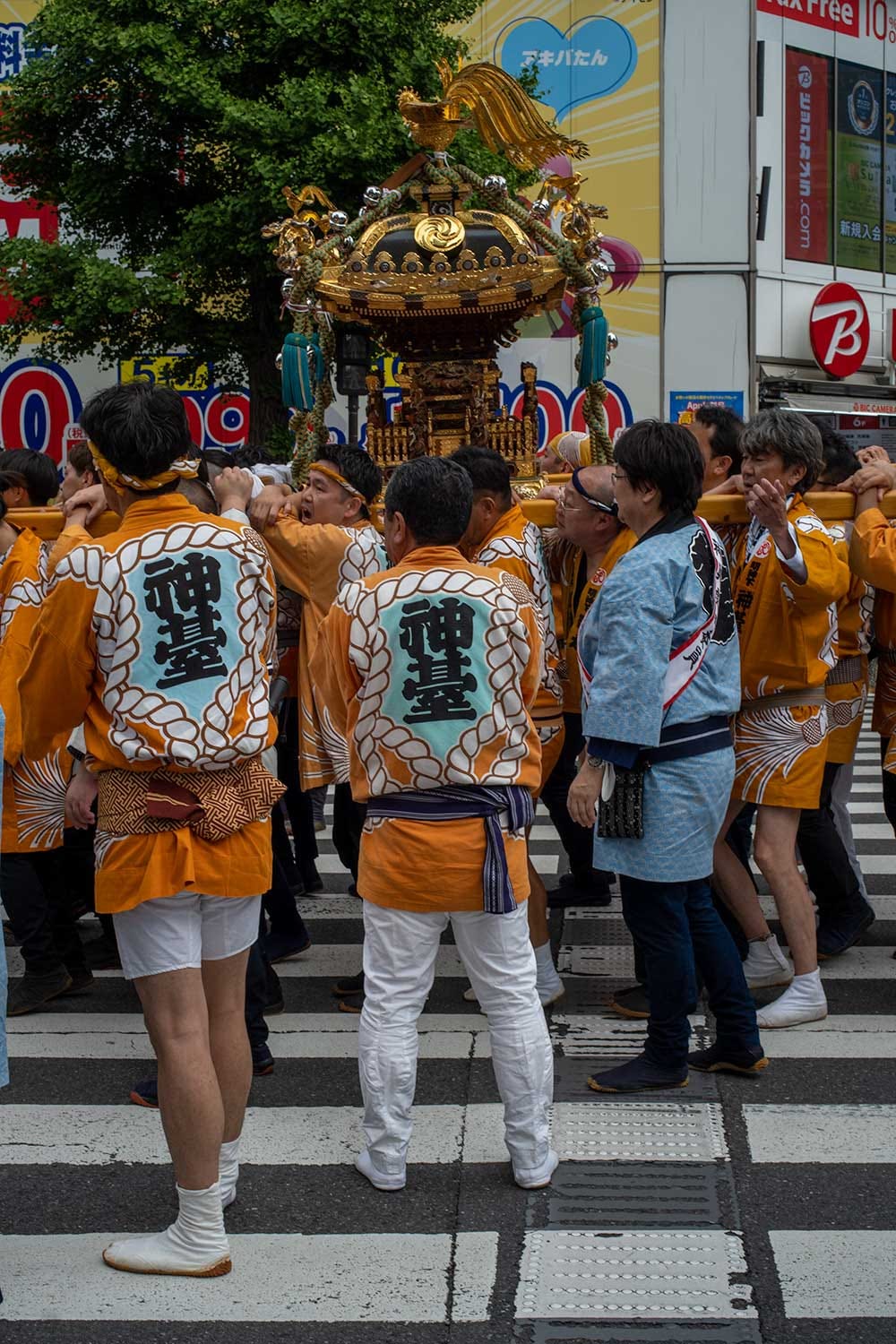Welcome to NOTEBOOK, a cultural guide to art, design and architecture, along with a resource of local news and information in English giving a realistic view of Tokyo and further afield.
05/15 – A strong earthquake with an estimated magnitude of 5.2 hit Chiba last week, with another measuring 5.1 hitting the southwestern prefecture of Kagoshima on Saturday. Tokyo reportedly has the second highest number of millionaires in the world. In Gifu prefecture, villagers in the UNESCO World Heritage site of Shirakawa village came together for the first time in five years to re-thatch one its well-known houses. And as the Daizafu-Tenmangu Shrine in Fukuoka undergoes renovation, a temporary hall at the shrine was unveiled, designed by the Japanese architect Sou Fujimoto.
The 1,300 year-ago Kanda Myoujin Shrine in Tokyo sits just above the Kanda River. We catch several gold mikoshi being carried on the shoulders of volunteers through the streets of Kanda and Akihabara as they make their way towards Kanda Myoujin for the bi-annual Kanda festival or matsuri.
The Kanda Festival is held every other year and is considered one of Japan’s three largest festivals, along with the Gion Festival in Kyoto and the Tenjin Festival in Osaka. This year marks the first time that the festival has taken place in 4 years, after the pandemic interrupted public events.
Starved of mass gatherings and foreign visitors, 108 different neighbourhood associations dotted throughout the city carried some 200 golden mikoshi through the streets of Chiyoda along 11 different routes, each one converging on Kanda Miyouji. The whole festival took place over the Saturday and Sunday of May 13th and 14th leading to most of Kanda, Akihabara and streets around Kanda Miyouji closed to traffic.
And while the gradual movement of each processions moved slowly through town weaving left and right of each other and the street, teams would stop and start. The event is steeped in such history that the exact nature of the event is hard to fathom to the casual passerby but the sight of a handful of mikoshi being carried through the same street by different neighbourhood associations was a sight to behold. Whatever is lost in its mythology is made up for by the celebration of being outside in public.
One of these neighbourhood groups was Kanda Goken-cho.
In the Edo period (1603-1867), this area was the residence of the Kuroda family of the Kazusa Kururi domain, the Oseki family of the Shimotsu-kurobane domain, the Sakai family of the Awa Katsuyama domain, the Tatebe family of the Harima Hayashida domain, the Matsudaira family of the Shinano-Ueda domain, and the Matsudaira family of the Shinano-Ueda domain.
The Matsudaira family had five residences in the area: including the Sakai family's upper house, the Matsudaira family's upper house, the Matsudaira family's lower house, and the Matsudaira family's lower house, lending the area it’s name Goken-cho.
During the Meiji Restoration (1868-1912), these residences were taken away by the government and used as mulberry and tea plantations. In 1872 (Meiji 5), the area was named Kanda Goken-cho and lined with houses. In the 1870s, the town became very lively with famous tempura restaurants and bars.
In 1911, the name of the town was changed to Goken-cho after Kanda was dropped, but in 1947, when Kanda Ward and Kojimachi Ward merged to Chiyoda City, the name was changed back to Kanda Goken-cho again. In 1964, with the implementation of the residential addresses, the name was changed to Soto-Kanda Roku-chome. [link]
Another neighbourhood team was Dōbochō-kai, named after a temple estate and residence used by shogunate dōhōshū before being moved after the Great Fire of Meireki in 1657.
Dōhō-shū were a small group of priests who performed tea ceremonies and other duties for the shogunate at the start of the Muromachi period (1336-1573).
Later in the Edo period, they followed feudal lords through the castle, dressed their masters, carried armament, and acted as a de-facto assistants wherever their shogun masters went.
The Kanda-kai neighbourhood association hails from an area just below the Myoujin Otoko-zaka stone steps: an area known as ‘Kitchen Town’ as recently as 1964.
Until the Great Fire of Meireki (1657), the neighbourhood was the territory of Koryu-ji Temple of Nichiren Buddhism and Manryu-ji Temple of Soto Buddhism. The origins of Kitchen Town stem from the back of the castle being rebuilt as a samurai residence serving the kitchen inside the castle, known by its former name Odaisho-machi.
In 1672, at the request of shogun who lived here, machiya town houses were built. From then on, Odaisho-machi developed into a merchant town. Its proximity to Kanda Myojin meant it was given the longer name Kanda Myojinshita Odaisho-machi, which changed to Kanda Kitchen-machi (Kitchen Town) in 1872.
The name Kanda-kai was first used in 1894, the year of the Sino-Japanese War. The 'Ishibashi' float commemorating the victory in the Russo-Japanese War was decorated with lanterns, with the upper lantern reading 'Kanda-kai' and the lower lantern reading 'Taisho-machi'. A taiko drum made just after the end of the war in 1946 was also engraved with the characters ‘Kanda-kai’, used ever since as the name of the town council, now in its 127th year.
The Kanda-kai has a strong sense of pride as a neighbourhood of Kanda Myojin, an area as complex as its address, covering 6-9 Sotokanda, while excluding 7-1 Sotokanda, 4 Sotokanda, and 5-1-12 Sotokanda 2-chome. [link]
As rich and complex as this history is, the sight of each group’s livery, or hanten, makes for an extraordinary sight. Further reading (in Japanese) on the mikoshi, hanten, and the lanterns of each neighborhood in Kanda can be found here: https://www.kandamyoujin.or.jp/kandasai/h31/neighborhood/
NOTEBOOK episodes are published 3 times a week: Monday, Wednesday, and Friday. We will add things here we couldn’t fit into each episode and use this space as somewhere to answer your questions when your here or thinking of visiting Japan.
It wont necessarily be chronological: we’ll dive back into previous episodes and expand on things that wouldn’t fit — you can only record so much.
We have recently been adding field recordings from different parts of the city, and different parts of the country, while interviews give us a chance to talk with other people on the places they might recommend (or not, for that matter).
And if you have an recommendations or requests, send an email (notebook.podcast@gmail.com) or voice message (speakpipe.com/notebook). Better still, Subscribe and add a comment below. Thanks for listening, thanks for reading, and feel free to use this as your NOTEBOOK.











